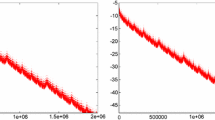Abstract
A class of analytic (possibly) time-dependent Hamiltonian systems withd degrees of freedom and the “corresponding” class of area-preserving, twist diffeomorphisms of the plane are considered. Implementing a recent scheme due to Moser, Salamon and Zehnder, we provide a method that allows us to construct “explicitly” KAM surfaces and, hence, to give lower bounds on their breakdown thresholds. We, then, apply this method to the HamiltonianH≡y 2/2+ε(cosx+cos(x−t)) and to the map (y,x)→(y+ε sinx,x+y+ε sinx) obtaining, with the aid of computer-assisted estimations, explicit approximations (within an error of ∼10−5) of the golden-mean KAM surfaces for complex values of ε with |ε| less or equal than, respectively, 0.015 and 0.65. (The experimental numerical values at which such surfaces are expected to disappear are about, respectively, 0.027 and 0.97.) A possible connection between break-down thresholds and singularities in the complex ε-plane is pointed out.
Similar content being viewed by others
References
Arnold, V.I.: Proof of a Theorem by A.N. Kolmogorov on the invariance of quasiperiodic motions under small perturbations of the Hamiltonian. Russ. Math. Surv.18, 9 (1963)
Arnold, V.I., Avez, A.: Ergodic problems of classical mechanics. New York: Benjamin 1968
Aubry, S., Le Daeron, P.Y.: The discrete Frenkel-Kontorova model and its extensions. I. Physica8, 381 (1983)
Benettin, G., Galgani, L., Giorgilli, A.: Realization of holonomic constraints and freezing of high frequency degrees of freedom in the light of classical perturbation theory. Part I. Commun. Math. Phys.113, 87 (1987)
Benettin, G., Gallavotti, G.: Stability of motions near resonances in quasi-integrable Hamiltonian systems. J. Stat. Phys.44, 293 (1986)
Braess, D., Zehnder, E.: On the numerical treatment of a small divisor problem. Numer. Math.39, 269 (1982)
Celletti, A., Chierchia, L.: Rigorous estimates for a computer-assisted KAM theory. J. Math. Phys.28, 2078 (1987)
Celletti, A., Falcolini, C., Porzio, A.: Rigorous numerical stability estimates for the existence of KAM tori in a forced pendulum. Ann. Inst. Henri Poincaré47, 85 (1987)
Chirikov, B.V.: A universal instability of many dimensional oscillator systems. Phys. Rep.52, 263 (1979)
Eckmann, J.-P., Wittwer, P.: Computer methods and Borel summability applied to Feigenbaum's equation. Lecture Notes in Physics, Vol. 227. Berlin, Heidelberg, New York: Springer 1985
Eliasson, H.: Absolutely convergent series expansions for quasiperiodic motions, preprint. Univ. of Stockholm (1987)
Escande, D.F.: Stochasticity in classical Hamiltonian systems: Universal aspects. Phys. Rep.121, 165 (1985)
Escande, D.F.: Private communication
Escande, D.F., Doveil, F.: Renormalization method for computing the threshold of the largescale stochastic instability in two degrees of freedom Hamiltonian systems. J. Stat. Phys.26, 257 (1981)
Falcolini, C.: Private communication
Gallavotti, G.: Perturbation theory for classical Hamiltonian systems. In: Scaling and self-similarity in physics. Fröhlich, J. (ed.) PPh. 7, Boston: Birkhäuser 1984
Greene, J.M.: A method for determining a stochastic transition. J. Math. Phys.20, 1183 (1979)
Hénon, M., Heiles, C.: The applicability of the third integral of motion: Some numerical experiments. Astron. J.69, 73 (1964)
Herman, M.: Sur le courbes invariantes par le difféomorphismes de l'anneau. Astérisque2, 144 (1986)
Iooss, G., Helleman, R.H.G., Stora, R. (eds.): Chaotic behaviour of deterministic systems. Amsterdam: North-Holland 1983
Kolmogorov, A.N.: On the conservation of conditionally periodic motions under small perturbation of the Hamiltonian. Dokl. Akad. Nauk. SSR98, 469 (1954)
Lanford III, O.E.: Computer assisted proofs in analysis. Phys. A124, 465 (1984)
MacKay, R.S.: Transition to chaos for area-preserving maps. Lecture Notes in Physics, Vol. 247, p. 390. Berlin, Heidelberg, New York: Springer 1985
MacKay, R.S., Percival, I.C.: Converse KAM: Theory and practice. Commun. Math. Phys.98, 469 (1985)
Mather, J.N.: Existence of quasiperiodic orbits for twist homeomorphisms of the annulus. Topology21, 457 (1982)
Mather, J.N.: Non-existence of invariant circles. Ergodic Theory Dyn. Syst.4, 301 (1984)
Moser, J.: On invariant curves of area-preserving mappings of an annulus. Nach. Akad. Wiss. Göttingen, Math. Phys. K1. II1, 1 (1962)
Moser, J.: A rapidly convergent iteration method and non-linear partial differential equations. Ann. Scuola Norm. Sup. Pisa20, 265 (1966)
Moser, J.: Minimal solutions of variational problems on a torus. Ann. Inst. Henri Poincaré3, 229 (1986)
Moser, J.: Minimal foliations on a torus. Forschungsinstitut für Mathematik, ETH Zürich, September 1987
Nekhoroshev, N.N.: An exponential estimate of the time of stability of nearly integrable Hamiltonian systems. Russ. Math. Surv.32, 1 (1977)
Percival, I.C.: Variational principles for invariant tori and cantori, in nonlinear dynamics and the beam-beam interaction. AIP Conference Proceedings 57, p. 302. M. Month, J.C. Herrera (eds.). (1980)
Rüssmann, H.: On optimal estimates for the solutions of linear partial differential equations of first order with constant coefficients on the torus. Lecture Notes in Physics, Vol. 38, p. 598. Berlin, Heidelberg, New York: Springer 1975
Rüssmann, H.: On the existence of invariant curves of twist mappings of an annulus. Lecture Notes in Mathematics, Vol. 1007, p. 677. Berlin, Heidelberg, New York: Springer 1983
Salamon, D., Zehnder, E.: KAM theory in configuration space. Preprint 1987
Wayne, C.E.: The KAM theory of systems with short range interactions. I. Commun. Math. Phys.96, 311 (1984)
Wayne, C.E.: Bounds on the trajectories of a system of weakly coupled rotators. Commun. Math. Phys.104, 21 (1986)
Wisdom, J., Peale, S.J.: The chaotic rotation of Hyperion. Icarus58, 137 (1984)
(no author listed) Vax architecture handbook. Digital Equipment Corporation (1981)
Author information
Authors and Affiliations
Additional information
Communicated by J.-P. Eckmann
To our friend and colleague Paola Calderoni
Supported by Consiglio Nazionale delle Ricerche, Italy
Rights and permissions
About this article
Cite this article
Celletti, A., Chierchia, L. Construction of analytic KAM surfaces and effective stability bounds. Commun.Math. Phys. 118, 119–161 (1988). https://doi.org/10.1007/BF01218480
Received:
Revised:
Issue Date:
DOI: https://doi.org/10.1007/BF01218480




